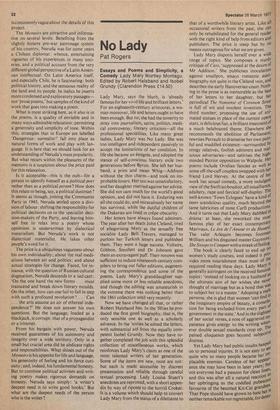No Lady
Pat Rogers
Essays and Poems and Simplicity, a Comedy Lady Mary Wortley Montagu. Edited by Robert Halsband and Isobel Grundy (Clarendon Press £14.50) Lady Mary, says the blurb, is 'already famous for her vivid life and brilliant letters.' For an eighteenth-century aristocrat, a woman moreover, life and letters ought to have been enough. But no, she had the temerity to stray into journalism, satire, politics, medical controversy, literary criticism—all the professional specialities. Like many great ladies, Lady Mary was No Lady. She was too intelligent and independent passively to accept the limitations of her condition. in life she became an emigree, and adopted the stance of self-conscious literary exile two generations before Byron. She left her husband, a prim and mean Whig—Addison without the thin charm—and took on improbable lovers. Her son was unsatisfactory, and her daughter married against her advice. She did not care much for the world's good opinion, and did not have it. Enduring was all she could do, and miraculously her name has survived, while the dutiful children of the Dukeries are lined in crêpe obscurity.
Her letters have always found admirers. The year after her death John Cleland, tired of allegorising Mary as the sexually free socialite Lady Bell Travers, managed to purloin her Turkish letters and published them. They were a huge success. Voltaire, Gibbon, Smollett and Dr Johnson gave them an extravagant puff. Their renown was sufficient to induce nineteenth-century compilers to bring out fuller editions, augmenting the correspondence and some of the poems. Lady Mary's granddaughter supplied some more or less reliable anecdotes, and though the editing was amateurish in the extreme there was nothing better than the 1861 collection until very recently.
Now we have changed all that, or rather Robert Halsband has. In the 'fifties he produced the first good biography, that is, the only sensible one as well as a scholarly advance. In the 'sixties he edited the letters, with substantial aid from the equally competent Isobel Grundy. Now they have together completed the job with this splendid collection of miscellaneous works, which reinforces Lady Mary's claim as one of the most talented writers of her generation. Some of the items are new,. most are not: but each is made accessible by discreet presentation and reliable through careful textual processing. Lady Louisa Stuart's anecdotes are reprinted, with a short appendix by way of riposte to the horrid Croker. It is a volume which should help to convert Lady Mary from the status of a dilettante to that of a worthwhile literary artist. Like all occasional writers from the past, she can only be rehabilitated for the general reader with the right kind of help from editors and publishers. The price is steep but by 110 means outrageous for what we are given.
Lady Mary disports herself over a wide range of topics. She composes a sturdY critique of Cato, 'suppressed at the desire of Mr Addison.' She publicises inoculation against smallpox, essays romantic autobiography not quite in the Cleland vein, and describes the early Hanoverian court. Nothing in the prose is as memorable as the best of her letters to her daughter, but her periodical The Nonsense of COMP77011 Sense is full of wit and insolent invention. The third number, proposing the use of ani" mated statues in place of the current °Per°, stars, is delicious fun, a brilliant treatment °I a much belaboured theme. Elsewhere she recommends the abolition of Parliament, rewrites Perrault to dramatise her own pain" ful and muddled existence—surrounded bY stingy relatives, foolish admirers and Mal' icious adversaries—and satirises the high" minded Patriot opposition to Walpole. Her poems include Ovidian fancies as well as some off-the-cuff couplets swapped with her friend Lord Hervey. At the centre of tier work lies sexual comedy, a more indulgent view of the Swift ian boudoir, all misalliance, adultery, rape and farcical self-display. The, well-known 'Town Eclogues' have a kind° inner scandalous quality, much beyond the tame lubricities of most Curll productions. And it turns out that Lady Mary dabbled in drama: at least, she reworked the most famous play of her exact ContemporarY Marivaux, Le Jeu de l' Amour et du Hasard. The valet Arlequin becomes footman William and his disguised master GayMore; She Stoops to Conquer with a streak of feeling' The book is clearly fated to end Li P women's study courses, and indeed it Pr°vides more nourishment than most of th,e required reading these days. Lady MarY 's generally astringent on the received feminist topics: 'instead of looking on a husband as the ultimate aim of her wishes she never thought of marriage but as a bond that'ias to subject her to a master.' Adopting a 1118,le persona, she is glad that women 'can find In the imaginary empire of beauty, a consolation for being excluded from every part 01t government in the state.' And in the slightes of her social verses, a note of aggrieved "1l patience gives energy to the writing when; ever double sexual standards crop up. T.h, pained eloquence goes beyond subjectiv'
distress. ed
Yet Lady Mary had public insults heaP „ on to personal injuries. It is not easy to se' quite why so many people became her in: placable enemies. Careless of her apPea_it ance she may have been in later years; not everyone had a passion for clean linen, and this was after all a natural reaction In't her upbringing as the coddled Pubes,ce s.. favourite of the besotted Kit-Cat granoee., That Pope should have grown to hate her neither remarkable nor regrettable, for detes
tation was the source of his creativity and his insight. Somehow people at large feared her, aware of her unusual gifts, shocked at her rejection alike of aristocratic blandness and of bourgeois respectability. She seems Less odd now, and eminently worth getting to know.



































 Previous page
Previous page